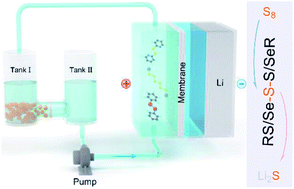A self-healing Li–S redox flow battery with alternative reaction pathways†
Abstract
Lithium–sulfur (Li–S) redox flow batteries (RFBs) have high energy density because of the high capacity of sulfur. To fully utilize its capacity, one key issue has to be overcome, i.e., the shuttle effect of intermediate lithium polysulfides resulting in the passivation of lithium metal anodes. Herein, we introduce two highly soluble small organic molecules, i.e., 2,2′-dipyridyl disulfide (PySSPy) and diphenyl diselenide (PhSeSePh), as adjuvants into a Li–S RFB with sulfur powder as the active material, and a self-healing RFB with alternative reaction pathways is obtained. In the cycling process, some sulfur atoms are inserted into the molecular structures of the adjuvants to generate new active substances, e.g., PySSSPy, PhSeSSPy, and PhSeSSePh, which can alter the redox reaction pathways, accelerate the redox kinetics of sulfur and reduce the formation of lithium polysulfides. More importantly, the insoluble lithium disulfide/sulfide passivated on the lithium metal anode can be reactivated into soluble species which return to the redox reaction loop providing a superior sulfur utilization of 92% in a continuous flow battery. The battery can be continuously cycled with ultrahigh stability (200 cycles in a static battery and >100 h in a flow battery).



 Please wait while we load your content...
Please wait while we load your content...